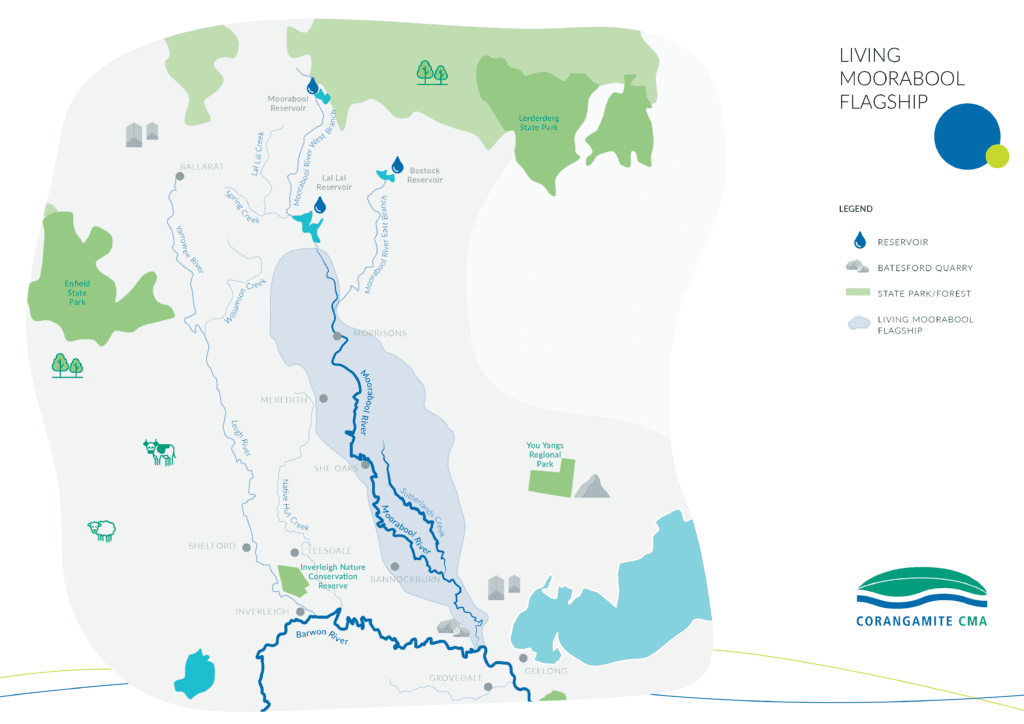Flowing southward from the Central Highlands between Ballarat and Ballan to join the Barwon River at Fyansford, the Moorabool ‘Yuluk’ River is on the traditional lands of the Wadawurrung people who have had an ongoing connection with the river for thousands of years.
The Moorabool River provides significant environmental value as a habitat for numerous native fish species of high conservation value such as the Australian grayling, river blackfish, Australian smelt, flat-headed gudgeon, southern pygmy perch, short-finned eel, spotted galaxias and tupong. Platypus, water rats and a range of waterbugs also call the river home.
The Moorabool River is also utilised as a water supply catchment by both Barwon Water and Central Highlands Water corporations who are water providers for Geelong and Ballarat – two of the fastest growing regions in Victoria. It is also heavily farmed with virtually 65% of its 1,150km2 deemed as agricultural-related land cover.
The Living Moorabool Flagship is a series of connected projects that all aim to improve the health of the Moorabool River downstream of the Lal Lal Reservoir, and the West Branch of Sutherland Creek. The 2040 vision is to progress towards 'healthy people, healthy environment, and healthy culture'.
The project is about people, their connection to the river and how they may be able to contribute to improving the waterway health of the river. This could be through citizen science programs, improved knowledge and understanding or a better understanding of the cultural significance of the river.
The project is also about physical works that will improve waterway health. This is through planning and delivery of water allocated for environmental outcomes (environmental water) and rehabilitating targeted areas of land next to the river (riparian land) through enhancing the vegetation.
Flagship Waterway projects are one of the actions supported by the Rivers of the Barwon (Barre Warre Yulluk) Action Plan.

The Corangamite CMA ‘E-Water’ team have been working towards improving the Moorabool River’s flow using strategic releases of water into the waterway.
Through this we aim to improve the health of the waterway and bolster the resilience of important habitats during dry flow periods.
Water for the environment priorities in the Moorabool River.
The current environmental entitlement can have the greatest effect on the river reaches between Lal Lal Reservoir and She Oaks Weir. The entitlement is insufficient to support the whole system and therefore has diminishing benefit to the reaches downstream, that are further away from the release point. Listed below are the priorities for E-Water delivery from highest to lowest. There is insufficient water in the current entitlement to deliver them all, however they are all important
For live flow data information, explore the interactive Moorabool River map here.
Learn more about what the ‘E-Water’ team does on the Moorabool River here.
Citizen Science aims to maintain and improve the connections between people and their local waterways. Corangamite CMA is supporting WaterWatch volunteers to conduct short and long-term monitoring in the Living Moorabool Flagship area.
The monitoring undertaken is used to help inform decisions regarding the future management of the river. There is a strong focus on assessing water quality through the monthly water testing program.
Seasonal waterbug surveys are done in spring and autumn to provide a picture of waterway health that can be used to monitor change in the environment associated with restoration activities and delivery of water for the environment. This information is publicly available at the WaterWatch Portal and National Waterbug Blitz portal (click on the interactive maps in the portals to find Living Moorabool Flagship data).
If you would like to get involved in a volunteer program click here, to register your interest.
Also check the Corangamite CMA Events page to participate in upcoming events such as Waterbug Discovery Days.
Riparian land is the ‘buffer zone’ between water and land. The land could be used for anything from a recreation reserve to an area for livestock to graze. It’s important to keep riparian land healthy and well covered with vegetation to help maintain a healthy waterway.
The Corangamite CMA Waterway Protection Program run Expression of Interest (EOI) campaigns in the Moorabool, Leigh River and Lake Corangamite catchment areas. Incentives are available for fencing, weed control, revegetation, stock crossings and off-stream water points, willow removal and pest animal management.
Learn more about what the Waterways team have done for the Corangamite region here.
In 2023 the ARI conducted a study into vegetation monitoring on the Moorabool River to evaluate and inform environmental watering. The report can be found here.
Barwon Water is Victoria’s largest regional urban water corporation. It services a population of more than 320,000 people, which rises to more than 545,000 people in peak periods.
To find out more about how their work relates to the importance of water conservation, visit: https://www.barwonwater.vic.gov.au/community-and-education/community-support/our-water-their-home
Paulina Gutierrez-Ramos commenced the Living Moorabool PhD research project in early 2021 focusing on land use change in the Moorabool catchment and its impact on river health. The project is a joint initiative of Barwon Water and the Corangamite CMA.
Paulina’s research questions cover:
She will be collaborating with a team of scientists from CSIRO and the Blue Carbon Lab at Deakin University while having conversations with various people who live and work in the catchment. Please reach out to Paulina if you are interested in participating in this research.
Paulina Gutierrez-Ramos pgutierrezramos@deakin.edu.au
The Living Moorabool E-Newsletter, Autumn 2024
The Living Moorabool E-Newsletter, Spring 2023
The Living Moorabool E-Newsletter, Autumn 2023
The Living Moorabool Flagship E-Newsletter, Spring 2022
The Living Moorabool Flagship E-Newsletter, Summer 2022
64 Dennis Street, Colac VIC 3250
PO Box 159, Colac, VIC 3250
Hours: 8:30am – 5pm, Monday to Friday
T: 1800 002 262
E: info@ccma.vic.gov.au
BARWON WATER OFFICES
Hours: 8:30am – 5pm, Monday to Friday
All mail must be sent via our Colac office
PO Box 159, Colac, VIC 3250
T: 1800 002 262
E: info@ccma.vic.gov.au
 Close
Close